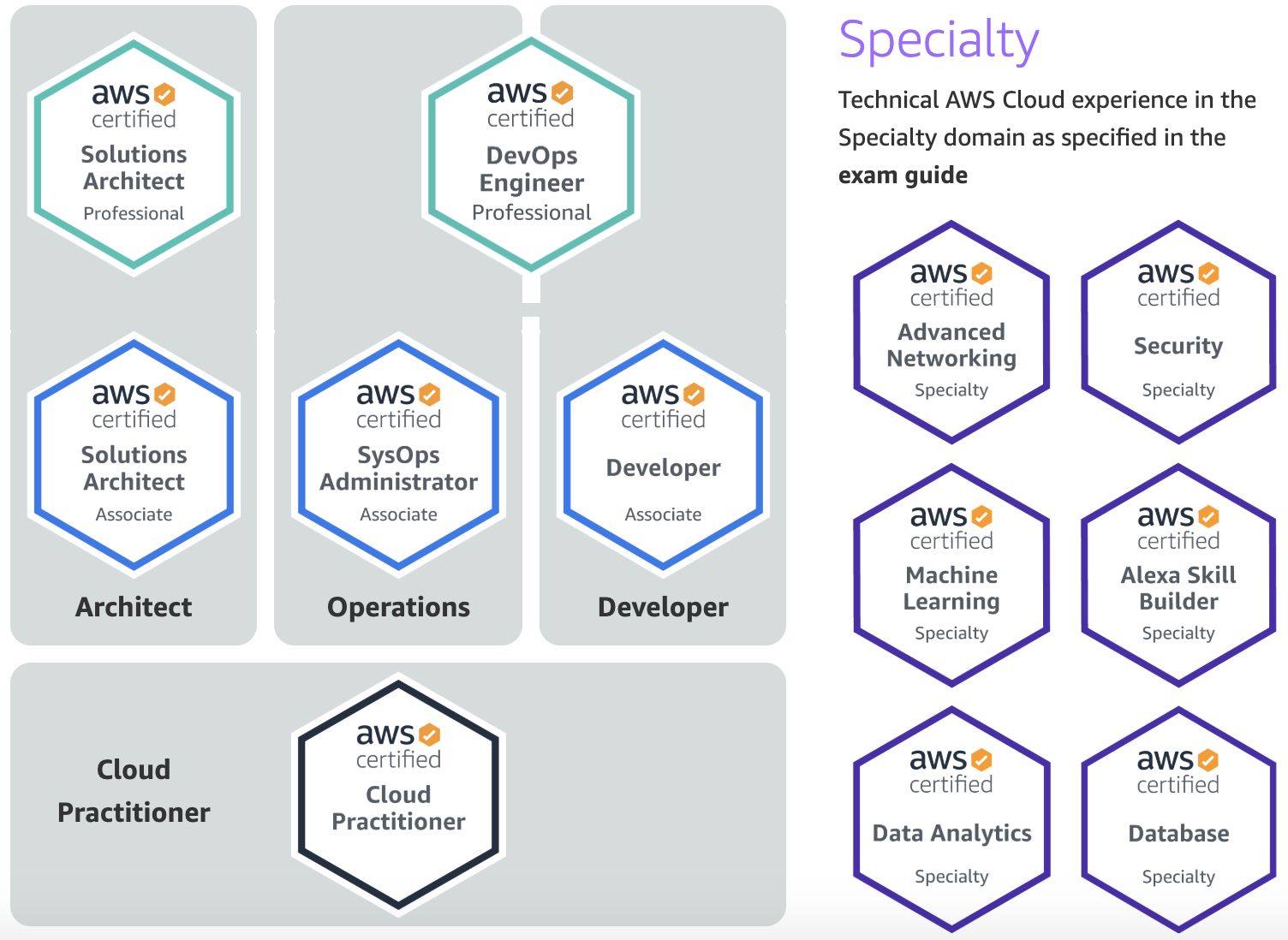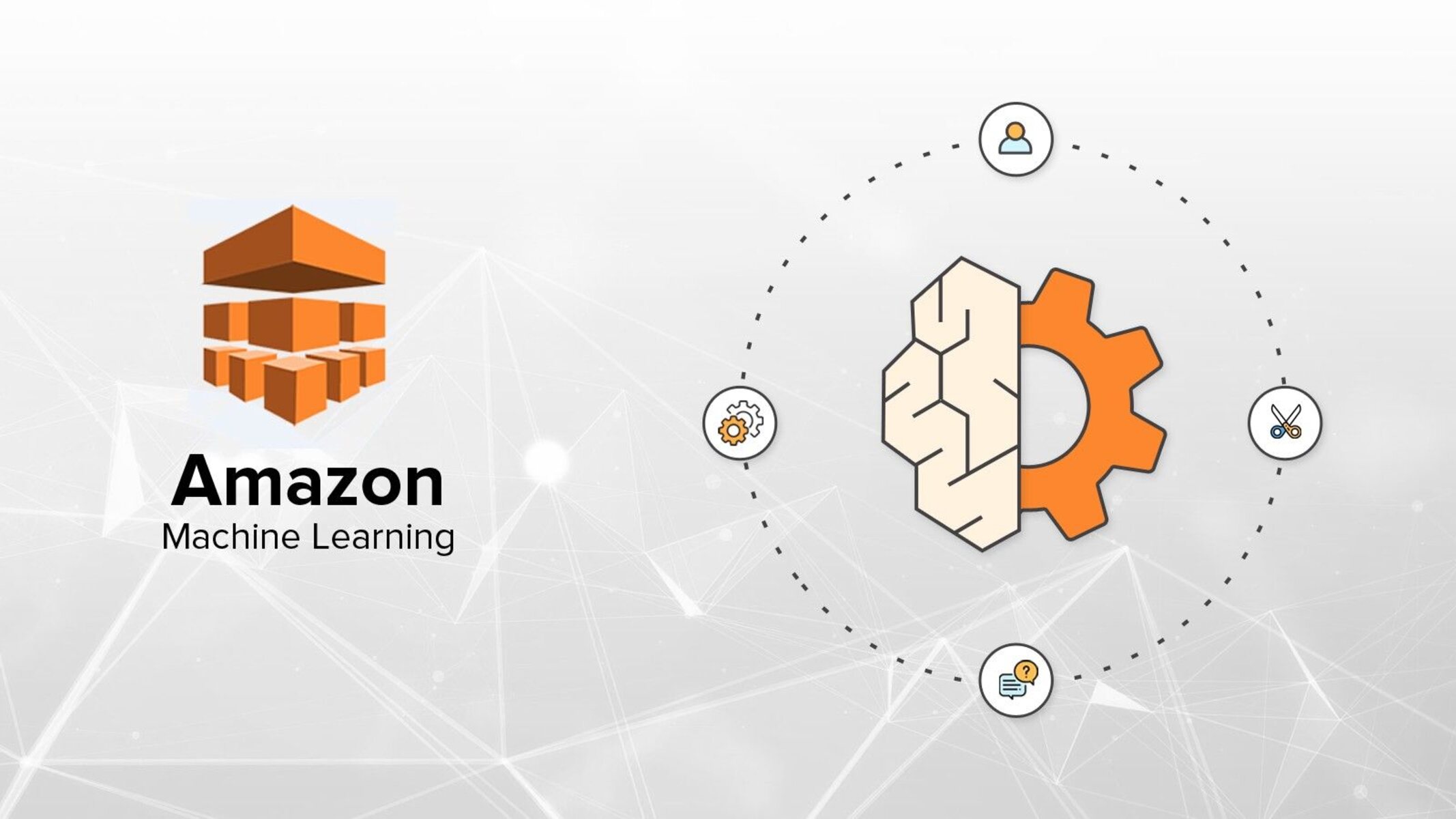Introduction
Welcome to the world of AWS Machine Learning Certification! If you are passionate about the field of machine learning and want to showcase your expertise, obtaining an AWS Machine Learning Certification is a great step towards achieving your goals. This certification validates your knowledge and skills in building, deploying, and managing machine learning models on the AWS platform.
In today’s data-driven world, machine learning has become an essential tool for businesses to gain insights and make better decisions. AWS, as a leading cloud service provider, offers a comprehensive suite of machine learning services and tools that enable practitioners to harness the power of machine learning and build highly scalable and efficient models.
By pursuing the AWS Machine Learning Certification, you open up doors to exciting career opportunities and demonstrate your proficiency in applying machine learning concepts to real-world scenarios. Whether you are an aspiring data scientist, a machine learning engineer, or a software developer looking to expand your skills, this certification will enhance your professional credibility and set you apart from the competition.
This article will guide you through the journey of preparing for the AWS Machine Learning Certification. We will provide an overview of the certification, discuss the prerequisites, explore the exam structure and topics, recommend study materials, and share helpful tips for exam preparation and success.
While this certification is designed for individuals with prior knowledge of machine learning, it is also suitable for those looking to switch careers or dive into the exciting field of artificial intelligence. So, if you have a passion for data, an analytical mindset, and a desire to learn, the AWS Machine Learning Certification is for you. Are you ready to take your machine learning skills to new heights? Let’s get started on this exhilarating journey!
Understanding the AWS Machine Learning Certification
The AWS Machine Learning Certification is a reputable credential offered by Amazon Web Services (AWS) that validates your expertise in designing and implementing machine learning solutions on the AWS platform. This certification demonstrates your ability to leverage AWS services to build and deploy accurate, scalable, and cost-effective machine learning models.
To earn the certification, you must pass the AWS Certified Machine Learning – Specialty exam. This exam is designed to assess your knowledge and skills in various areas of machine learning, such as data preparation and feature engineering, model training and evaluation, deployment and management of models, and monitoring and securing machine learning solutions.
By obtaining the AWS Machine Learning Certification, you demonstrate your proficiency in implementing machine learning algorithms, selecting appropriate AWS services for different use cases, and optimizing the performance and scalability of machine learning solutions. This certification not only enhances your credibility as a machine learning professional but also provides you with a solid foundation to tackle complex business problems and deliver innovative solutions.
One of the key advantages of the AWS Machine Learning Certification is that it is recognized globally and highly regarded by employers in various industries. Companies across different sectors, including finance, healthcare, e-commerce, and more, are increasingly adopting machine learning to gain a competitive edge. As a certified professional, you are equipped with the knowledge and skills to contribute to these organizations’ success by leveraging AWS services for machine learning.
The AWS Machine Learning Certification is suitable for a range of professionals, including data scientists, machine learning engineers, software developers, and solution architects. It is ideal for individuals who have a solid understanding of machine learning concepts and a strong foundation in AWS services. While prior experience in AWS is not mandatory, it is beneficial to have some familiarity with AWS offerings such as Amazon SageMaker, AWS Lambda, Amazon S3, and Amazon Redshift.
Preparing for the certification exam requires a comprehensive understanding of machine learning principles and hands-on experience with AWS services. In the next sections, we will explore the prerequisites for the certification and provide guidance on how to effectively prepare for the exam. Whether you are an experienced professional or just starting your journey in machine learning, the AWS Machine Learning Certification will enable you to showcase your expertise and excel in your career.
Prerequisites for the Certification
Before pursuing the AWS Machine Learning Certification, it is important to ensure that you meet the necessary prerequisites. These requirements are designed to ensure that you have the foundational knowledge and skills required to successfully understand and implement machine learning solutions on the AWS platform.
Although there are no strict prerequisites set by AWS, it is highly recommended to have a solid understanding of machine learning concepts and some experience with AWS services. This will help you grasp the advanced concepts covered in the certification exam and enable you to effectively apply machine learning techniques using AWS tools and services.
Here are the key prerequisites to consider before embarking on your journey to become an AWS Machine Learning certified professional:
- Machine Learning Fundamentals: It is essential to have a strong foundation in machine learning concepts, algorithms, and techniques. Understanding key concepts such as supervised learning, unsupervised learning, regression, classification, and model evaluation is crucial for success in the certification exam.
- Programming Skills: Proficiency in at least one programming language is necessary for implementing machine learning models. Python is widely used in the machine learning community, and familiarity with libraries such as NumPy, Pandas, and Scikit-learn is highly recommended.
- AWS Fundamentals: While not mandatory, having a basic understanding of AWS services and architectures will greatly benefit your preparation process. Familiarity with services such as Amazon S3 (Simple Storage Service), AWS Lambda, and Amazon EC2 will help you understand how these services integrate with machine learning workflows.
- Statistics and Probability: A solid understanding of statistics and probability theory is essential for machine learning. Concepts such as hypothesis testing, probability distributions, regression, and statistical inference are commonly used in building and evaluating machine learning models.
- Data Manipulation and Visualization: Proficiency in data manipulation and visualization techniques is crucial for building accurate and meaningful machine learning models. Experience with tools like SQL and data manipulation libraries like Pandas will help you preprocess and analyze data effectively.
- Hands-on Experience: While not a formal prerequisite, practical experience in implementing machine learning projects will greatly enhance your understanding of the subject matter. Engaging in real-world projects, participating in Kaggle competitions, or working on personal machine learning projects will provide invaluable hands-on experience.
By ensuring that you have a solid foundation in these prerequisites, you will be well-prepared to dive into the AWS Machine Learning Certification journey. It is important to note that these prerequisites are not strict requirements, but they will significantly contribute to your success in the certification exam and help you fully comprehend the concepts and techniques covered.
Exam Structure and Topics Covered
The AWS Machine Learning Certification exam is designed to test your knowledge and skills in various aspects of machine learning on the AWS platform. Understanding the exam structure and topics covered will help you effectively prepare and perform well on the certification exam.
The exam is delivered in a proctored format and consists of multiple-choice and multiple-response questions. The duration of the exam is 170 minutes (2 hours and 50 minutes), during which you will need to answer a series of questions that assess your understanding of machine learning concepts and your ability to apply them using AWS services.
The exam will cover the following key topics:
- Data Engineering: This topic focuses on data gathering, exploration, and preparation. You will need to demonstrate your knowledge of different data types, data cleaning techniques, and feature engineering to create meaningful datasets for machine learning models.
- Data Analysis and Visualization: This topic tests your ability to analyze and visualize data to gain insights and make informed decisions. You should be familiar with statistical analysis, data visualization techniques, and data interpretation.
- Machine Learning Algorithms: This topic covers the fundamentals of various machine learning algorithms such as regression, classification, clustering, and dimensionality reduction. You need to understand the underlying principles, strengths, and limitations of each algorithm.
- Model Training and Evaluation: Here, you will be assessed on your knowledge of model training techniques, hyperparameter tuning, and model evaluation metrics. Understanding how to optimize model performance and interpret evaluation results is crucial.
- AWS Machine Learning Services: This topic focuses on AWS services specific to machine learning, such as Amazon SageMaker, AWS Glue, and AWS Lambda. You should be familiar with the functionalities and features of these services and understand how to use them effectively in machine learning workflows.
- Deployment and Management: This section evaluates your ability to deploy machine learning models in production environments, manage endpoint configurations, and perform model versioning and A/B testing.
- Security and Compliance: This topic covers security best practices, data privacy, and compliance considerations in machine learning implementations using AWS services. You need to understand how to secure data and models and comply with industry regulations.
It is important to review and understand these topics thoroughly, as the exam questions will assess your knowledge and practical application of these concepts. AWS provides a detailed exam guide that outlines the specific knowledge areas and skills measured in the exam. You can use this guide as a reference to plan your study strategy and ensure comprehensive coverage of the exam topics.
In the next sections, we will explore recommended study materials and preparation techniques to help you succeed in your journey towards earning the AWS Machine Learning Certification.
Recommended Study Materials
To effectively prepare for the AWS Machine Learning Certification exam, it is important to gather the right study materials that cover the necessary topics and provide comprehensive guidance. Here are some recommended study materials to help you in your preparation:
- AWS Certified Machine Learning – Specialty Exam Guide: This official exam guide provided by AWS gives you insights into the exam structure, key topics, and sample questions. It is a valuable resource to understand the content and format of the exam, and it helps you align your study efforts accordingly.
- AWS Machine Learning documentation: The official AWS Machine Learning documentation provides in-depth information on various AWS services and tools used in machine learning. It offers detailed instructions, tutorials, and examples to help you understand the concepts and practice implementing them in real-world scenarios.
- Online Courses and Training: There are several online platforms that offer specialized courses and training programs for AWS Machine Learning Certification. Providers such as Udemy, Coursera, and A Cloud Guru offer comprehensive courses that cover the exam topics and provide hands-on practice with AWS services.
- Hands-on Experience: One of the best ways to solidify your understanding of machine learning concepts and AWS services is through hands-on experience. Perform practical exercises, work on real-world machine learning projects, and participate in online competitions like Kaggle to apply your knowledge and gain practical skills.
- Community Forums and Discussion Groups: Engage with the AWS community by joining forums and discussion groups focused on AWS Machine Learning Certification. These platforms are a valuable source of information, tips, and insights from professionals who have successfully achieved the certification. They can also help clarify any doubts or provide additional study resources.
Additionally, it is important to stay updated with the latest trends and advancements in the field of machine learning. Read industry publications, research papers, and blogs to expand your knowledge beyond the exam requirements and understand how machine learning is evolving in various domains.
Remember, the key to success in the AWS Machine Learning Certification is a combination of theoretical understanding and practical application. Make sure to devote sufficient time to hands-on practice, as it will help solidify your knowledge and build confidence in working with AWS machine learning services and applying machine learning techniques.
By utilizing these recommended study materials and resources, you will be well-equipped to tackle the exam topics, understand the practical implications of machine learning on the AWS platform, and ultimately succeed in earning your AWS Machine Learning Certification.
Setting up an AWS Account
To fully explore and utilize the AWS services for machine learning, you will need to set up an AWS (Amazon Web Services) account. Setting up an account is a relatively straightforward process and will provide you with access to the AWS Management Console, where you can create and manage your resources.
Here are the steps to set up an AWS account:
- Go to the AWS website: Visit the official AWS website (https://aws.amazon.com) and click on the “Create an AWS Account” button. This will start the account creation process.
- Provide your email address and password: Enter a valid email address and create a secure password for your AWS account.
- Enter your account information: Fill in your account details, including your name, address, and contact information.
- Provide payment information: You will need to provide a valid payment method to cover any charges for the AWS services you use. AWS offers a free tier for certain services, which allows you to explore and experiment with them at no cost for a limited time.
- Verify your identity: AWS may require you to provide additional verification to ensure the security of your account. This may involve entering a code sent to your registered phone number or credit card verification.
- Read and accept the terms and conditions: Review the AWS Customer Agreement and the Pricing Information and then accept the terms and conditions to proceed.
- Complete registration: Once you have provided all the necessary information and accepted the terms and conditions, click on the “Create Account and Continue” button to complete the registration process.
After completing these steps, your AWS account will be set up and ready for use. You can access the AWS Management Console with your account credentials and begin exploring the various AWS services and tools, specifically those related to machine learning.
It is important to note that while setting up an AWS account is free, the usage of certain AWS services may incur charges. Therefore, it is crucial to understand the pricing details of each service you intend to use and monitor your usage to avoid unexpected costs. AWS provides detailed documentation on pricing for each service, which you can refer to for accurate cost estimation.
By setting up an AWS account, you gain access to a wide range of services and resources that are essential for building, deploying, and managing machine learning models on the AWS platform. Setting up an account is the first step in your AWS Machine Learning Certification journey and will pave the way for your success in mastering the intricacies of machine learning using AWS.
Familiarizing Yourself with AWS Services for Machine Learning
As you embark on your journey to earn the AWS Machine Learning Certification, it is essential to familiarize yourself with the AWS services that are specifically designed for machine learning. Understanding the capabilities, features, and use cases of these services will enable you to effectively leverage them in building, deploying, and managing machine learning models on the AWS platform.
Here are some key AWS services for machine learning that you should become acquainted with:
- Amazon SageMaker: This fully-managed service simplifies the process of building, training, and deploying machine learning models. With SageMaker, you can easily preprocess data, choose and tune algorithms, and deploy models at scale. It provides a comprehensive set of tools and resources to streamline the end-to-end machine learning workflow.
- Amazon Rekognition: Rekognition is a powerful computer vision service that can analyze and recognize objects, scenes, and faces in images and videos. You can use this service to incorporate image and video analysis capabilities into your applications, such as face recognition, object detection, and text extraction.
- Amazon Comprehend: Comprehend is a natural language processing (NLP) service that allows you to extract insights and relationships from text. It can perform tasks such as sentiment analysis, entity recognition, keyphrase extraction, and language detection. Comprehend is a powerful tool for analyzing unstructured text data.
- Amazon Forecast: Forecast is a fully-managed service for time-series forecasting. With Forecast, you can generate accurate forecasts for various business use cases, such as demand planning, inventory management, and sales forecasting. It utilizes machine learning algorithms to automatically detect trends and patterns in time-series data and provide accurate predictions.
- Amazon Personalize: Personalize is a service that allows you to build personalized recommendations for your applications. It utilizes machine learning algorithms to analyze user behavior and generate recommendations tailored to individual preferences. This service is especially useful for e-commerce platforms, content streaming services, and any application that requires personalized user experiences.
These are just a few examples of the many AWS services available for machine learning. Each service has its own strengths and use cases, and understanding which service is appropriate for a given task is crucial to building effective machine learning solutions on AWS.
To familiarize yourself with these services, you can explore the AWS documentation and participate in hands-on tutorials and exercises. AWS provides comprehensive documentation, guides, and sample code that demonstrate how to use these services effectively. Additionally, you can take advantage of online courses, training programs, and webinars offered by AWS to gain in-depth knowledge and practical experience with these services.
By familiarizing yourself with the AWS services for machine learning, you will be equipped with the knowledge and skills required to leverage these services in building innovative and intelligent solutions. Understanding the capabilities of each service and knowing when and how to apply them will be invaluable in your journey towards earning the AWS Machine Learning Certification.
Understanding the Basics of Machine Learning
As you delve into the world of AWS machine learning, it is important to have a solid understanding of the basics of machine learning. Machine learning is a subset of artificial intelligence that focuses on developing algorithms and models that can learn from data and make predictions or decisions without being explicitly programmed.
Here are some key concepts to grasp when it comes to machine learning:
- Data: In machine learning, data is the foundation. It consists of a collection of observations, measurements, or facts that are used to train machine learning models. Data can be classified into two types: labeled data, where each observation is already assigned a class or label, or unlabeled data, which lacks explicit class or label assignments.
- Features: Features are the individual measurable characteristics or attributes of the data. These can be numerical or categorical variables that help describe and differentiate the data points. Feature engineering is the process of selecting, transforming, and creating the most relevant features to improve the performance of machine learning models.
- Algorithms: Machine learning algorithms are mathematical procedures used to discover patterns or relationships in the data to make predictions or decisions. There are various types of machine learning algorithms, including supervised learning, unsupervised learning, and reinforcement learning. Each algorithm has its own strengths and is used for different types of problems.
- Training and Testing: Machine learning models are trained using a portion of the available labeled data. During training, the model learns patterns and relationships within the data. The trained model is then tested on a separate portion of labeled data to measure its performance and generalization ability. The goal is to build models that can accurately predict or classify unseen data.
- Evaluation Metrics: Evaluation metrics are used to assess the performance of machine learning models. Common metrics include accuracy, precision, recall, F1-score, and area under the curve (AUC). The choice of evaluation metric depends on the problem type and the desired outcome.
To deepen your understanding of these concepts, it is recommended to explore resources such as online courses, tutorials, books, and academic papers on machine learning fundamentals. Familiarizing yourself with the underlying principles and techniques will empower you to effectively work with machine learning models, evaluate their performance, and make informed decisions in the context of AWS machine learning services.
Machine learning is a diverse and evolving field, and staying up to date with the latest advancements and techniques is crucial. Engage with the machine learning community through forums, conferences, and meetups to gain insights and exchange knowledge with experts and practitioners in the field. Active participation in the community will help you stay informed about the latest trends and best practices in machine learning.
By understanding the basics of machine learning, you will be able to apply these concepts effectively to AWS machine learning services. This foundational knowledge will further support you in your journey towards earning the AWS Machine Learning Certification and becoming an accomplished machine learning professional.
Exploring AWS Machine Learning Services
AWS offers a comprehensive suite of machine learning services that enable practitioners to build, deploy, and manage machine learning models effectively. Exploring these AWS machine learning services is essential for understanding their functionalities, features, and use cases in order to leverage them for your own projects and prepare for the AWS Machine Learning Certification.
Here are some prominent AWS machine learning services worth exploring:
- Amazon SageMaker: SageMaker is a fully-managed service that simplifies the process of building, training, and deploying machine learning models. It provides pre-built algorithms, a Jupyter notebook interface for model development, and scalable infrastructure for training and deploying models. SageMaker makes it easy to experiment with different models and collaborate with team members.
- Amazon Rekognition: Rekognition is a computer vision service that allows you to analyze images and videos for object detection, face recognition, scene understanding, and more. It provides powerful APIs to easily incorporate computer vision capabilities into your applications without requiring deep computer vision expertise.
- Amazon Comprehend: Comprehend is a natural language processing (NLP) service that helps you analyze text to extract insights, sentiment, entities, and other valuable information. It supports multiple languages and provides easy-to-use APIs that enable you to build applications with NLP capabilities quickly.
- Amazon Forecast: Forecast is a service that uses machine learning to generate accurate forecasts for time series data. It automatically handles data cleaning, feature engineering, model training, and forecasting. Forecast is ideal for demand forecasting, sales planning, inventory optimization, and financial planning scenarios.
- Amazon Personalize: Personalize is a service that makes it easy to build customized recommendation systems. It utilizes machine learning algorithms and personalized algorithms to deliver relevant recommendations to users based on their behavior and preferences.
- Amazon Textract: Textract is a service that uses machine learning to extract text and data from documents such as PDFs and images. It can accurately recognize and extract structured and unstructured data from a wide variety of document types.
By exploring these AWS machine learning services, you will gain practical knowledge of how to leverage them for specific use cases. Each service has its own advantages and specializes in different aspects of machine learning, such as computer vision, natural language processing, and personalized recommendations. Understanding their capabilities and features will help you choose the most appropriate service for your specific machine learning applications.
To get started with these services, you can explore the AWS documentation, which provides detailed tutorials, guides, and sample code for each service. AWS also offers hands-on workshops, webinars, and online courses that allow you to gain practical experience and dive deeper into the features and functionalities of these services.
By becoming familiar with AWS machine learning services, you will be well-equipped to harness the power of these services to build intelligent and innovative solutions. This knowledge will not only benefit you in the AWS Machine Learning Certification exam but also support your journey towards becoming a proficient machine learning practitioner on the AWS platform.
Preparing Data for Machine Learning Models on AWS
Preparing data is a critical step in building machine learning models on the AWS platform. Clean, well-structured, and relevant data is essential for training accurate and effective models. By understanding the process of data preparation, you can ensure that your machine learning models perform optimally and produce meaningful insights.
Here are some key steps to consider when preparing data for machine learning models on AWS:
- Data Collection: Begin by collecting relevant data from various sources. This can include structured data from databases, unstructured data from text files, or even data from external APIs. Ensure that your data adequately represents the problem you are trying to solve and provides enough examples for the model to learn from.
- Data Cleaning: Data cleaning involves removing or correcting any noise, errors, or inconsistencies in the dataset. This includes handling missing values, dealing with outliers, standardizing data formats, and ensuring data quality. Cleaning the data is crucial for ensuring the accuracy and reliability of the machine learning models.
- Data Transformation: Data often needs to be transformed or reformatted to make it suitable for machine learning algorithms. This can involve feature scaling, normalization, or encoding categorical variables into numerical representations. Transforming the data helps the model understand patterns and relationships more effectively.
- Feature Engineering: Feature engineering involves selecting, creating, or transforming features to improve model performance. This can include creating new features from existing ones, selecting the most relevant features, or applying dimensionality reduction techniques. Feature engineering plays a crucial role in capturing the underlying patterns in the data.
- Splitting the Dataset: Divide the dataset into training, validation, and testing sets. The training set is used to train the machine learning model, the validation set is used to optimize the model’s hyperparameters, and the testing set is used to evaluate the final model’s performance. Careful splitting of the dataset ensures an unbiased assessment of the model’s generalization ability.
- Data Formatting: Ensure that the data is in the appropriate format for the AWS machine learning service you are using. Different services may have specific requirements for data input formats, such as CSV, JSON, or Parquet. Take the time to understand the specific data formatting requirements to ensure smooth integration with the AWS services.
- Data Scaling and Normalization: Depending on the specific machine learning algorithm you are using, you may need to scale or normalize your data. Scaling ensures that all features have a similar range of values, preventing certain features from dominating the learning process. Normalization can help in scenarios where your data follows a specific distribution.
AWS provides various tools and services that can assist you with data preparation tasks. Amazon S3 (Simple Storage Service) can be used to securely store and manage large datasets, while AWS Glue can help automate the data discovery, transformation, and cataloging process. Additionally, Amazon Athena can be used for querying and analyzing data stored in Amazon S3 using standard SQL queries.
Remember, the quality of your machine learning models heavily relies on the quality of your data. Spending time and effort on thorough data preparation will contribute to building accurate and reliable models on the AWS platform.
Building and Training Machine Learning Models on AWS
Building and training machine learning models on the AWS platform is an integral part of the data science journey. AWS offers a range of services and tools that enable you to develop and train models effectively. By understanding the steps involved in building and training machine learning models, you can leverage AWS services to create accurate and powerful models.
Here are key steps to consider when building and training machine learning models on AWS:
- Selecting the Right Algorithm: Choose the appropriate algorithm that best suits the problem you are trying to solve. AWS provides a diverse set of algorithms through services like Amazon SageMaker, which covers a wide range of use cases such as regression, classification, time-series forecasting, and natural language processing.
- Feature Engineering: As mentioned earlier, feature engineering plays a crucial role in model performance. Use techniques like dimensionality reduction, interaction features, and one-hot encoding to transform the data and make it more suitable for the selected algorithm. AWS provides built-in feature engineering capabilities in services like Amazon SageMaker that streamline this process.
- Model Training: Train your model using the labeled training data. Utilize AWS services like Amazon SageMaker to create training scripts that define the model architecture, hyperparameters, and optimization algorithms. AWS also offers distributed training capabilities to speed up the training process for larger datasets.
- Model Evaluation and Validation: After training, evaluate the performance of your model using validation datasets. AWS services like Amazon SageMaker provide built-in mechanisms to assess model performance and compare various models and hyperparameter settings. Use appropriate evaluation metrics, such as accuracy or mean squared error, to measure the model’s performance.
- Hyperparameter Tuning: Fine-tune your model by adjusting hyperparameters to optimize its performance. AWS services like Amazon SageMaker simplify hyperparameter tuning by automating the process and searching through a predefined parameter space to find the best combination of hyperparameters.
- Model Deployment: Once you have trained and validated your model, it’s time to deploy it and make predictions. AWS provides deployment options through services like Amazon SageMaker, where you can create model endpoints and integrate them into your applications using APIs.
- Monitoring and Iteration: Continuously monitor your deployed model’s performance and retrain it periodically using new and updated data. AWS offers solutions for monitoring model metrics, detecting concept drift, and retraining models to ensure they remain accurate and up-to-date.
It is important to note that AWS provides comprehensive documentation and tutorials for each service to guide you through the process of building and training models. Additionally, there are many online courses, webinars, and workshops available to help you learn the intricacies of building effective machine learning models on the AWS platform.
By leveraging the power of AWS services like Amazon SageMaker, you can build, train, and deploy machine learning models at scale, allowing you to solve complex problems and drive innovation in various domains. Mastering the process of building and training models on AWS is crucial for success in the AWS Machine Learning Certification and for becoming a proficient machine learning practitioner.
Deploying and Evaluating Machine Learning Models on AWS
Deploying and evaluating machine learning models is a crucial step in bringing your models into production and extracting valuable insights. AWS offers a range of services and tools that simplify the deployment and evaluation process, allowing you to efficiently deploy and assess the performance of your models on the AWS platform.
Here are key considerations when deploying and evaluating machine learning models on AWS:
- Model Deployment: AWS provides services like Amazon SageMaker for deploying trained models. You can create model endpoints and expose them as APIs, making it easy to integrate your models into applications or systems. This allows you to serve predictions in real-time, enabling live inference for a wide range of use cases.
- Monitoring & A/B Testing: Once your model is in production, it is essential to monitor its performance and identify any issues or concept drift that may affect its accuracy. AWS offers monitoring solutions and concepts like A/B testing, allowing you to compare the performance of different models or versions to ensure optimal results.
- Scaling and Efficiency: With AWS, you have the flexibility to scale your deployed models based on workload demand. Services like Amazon SageMaker allow you to automatically scale your model inference based on the incoming traffic, ensuring efficient resource utilization and reducing costs.
- Error Analysis and Debugging: It is important to perform thorough error analysis and debugging of your deployed models. AWS provides tools and services that enable you to collect and analyze prediction errors, identify patterns, and iteratively improve your models based on the insights gained from the analysis.
- Retraining and Continuous Improvement: As new data becomes available, periodically retrain your models to ensure they remain accurate and up-to-date. AWS offers solutions and workflows that make it easy to retrain and update models based on new data, helping you continuously improve the performance of your machine learning models.
AWS provides detailed documentation, tutorials, and best practices to guide you through the process of deploying and evaluating machine learning models. Services like Amazon SageMaker simplify the deployment process, providing a seamless environment for managing, scaling, and monitoring deployed models.
Evaluating the performance of your deployed models requires appropriate metrics and tools. AWS offers various solutions for monitoring model performance, collecting real-time or batch inference data, and measuring the impact and effectiveness of your models. By leveraging these tools, you can iteratively improve your models and gain crucial insights into their behavior and impact on business outcomes.
Successfully deploying and evaluating machine learning models on AWS is essential for achieving optimal results and driving value from your models. By leveraging the capabilities and services provided by AWS, you can ensure that your models are efficient, scalable, and accurate, making the most of the AWS Machine Learning Certification and becoming an accomplished machine learning practitioner.
Securing and Monitoring Machine Learning Applications on AWS
Securing and monitoring machine learning applications on AWS is crucial to protect sensitive data, ensure the integrity of models, and identify any potential issues or anomalies. AWS provides a range of security and monitoring features that allow you to implement robust measures for safeguarding your machine learning applications.
Here are key considerations when securing and monitoring machine learning applications on AWS:
- Data Security: Data security is paramount in machine learning applications. Utilize AWS services such as Amazon S3 and AWS Key Management Service (KMS) to encrypt sensitive data at rest and in transit. Implement access control and authentication mechanisms to ensure that only authorized users have access to your data.
- Model Security: Protect your machine learning models from unauthorized access or tampering by utilizing AWS Identity and Access Management (IAM) roles and policies. Implement encryption of model artifacts and ensure that only authorized individuals or systems can deploy or modify the models.
- Endpoint Security: When deploying machine learning model endpoints, secure them behind appropriate security measures. Utilize VPC (Virtual Private Cloud) configurations, security groups, and network ACLs (Access Control Lists) to restrict access and ensure that your endpoints are only accessible to authorized systems or users.
- Monitoring: Implement a robust monitoring system to track and monitor the behavior of your machine learning applications. AWS provides services like Amazon CloudWatch, which allows you to collect and analyze logs, metrics, and events related to your applications. Use this data to identify any abnormal behavior or potential security threats.
- Threat Detection & Response: Leverage AWS services such as AWS GuardDuty, which performs intelligent threat detection to identify potential security threats to your applications. GuardDuty continuously monitors your AWS environment for suspicious activities or unauthorized access attempts, providing you with valuable insights to help you respond effectively to security incidents.
- Performance Monitoring: Monitor the performance of your machine learning applications to ensure optimal efficiency. Utilize AWS services like AWS CloudWatch to track and analyze key performance metrics such as latency, throughput, and resource utilization. This helps you identify any performance bottlenecks and optimize your applications.
- Compliance: Ensure that your machine learning applications comply with relevant industry regulations and standards. AWS provides a comprehensive suite of compliance services and documentation to assist in meeting regulatory requirements, such as HIPAA, GDPR, and PCI-DSS.
To enhance security and monitoring, combine best practices with your machine learning workflows. This includes implementing secure coding practices, performing regular vulnerability assessments, and staying updated with security patches and updates for your AWS services and applications.
AWS offers resources, documentation, and security best practices to guide you through securing and monitoring machine learning applications. Understanding and implementing these measures ensures the integrity and reliability of your machine learning applications, protecting your data and providing peace of mind.
By following best practices for security and monitoring, you can create a robust environment for your machine learning applications on AWS. Developing a strong security posture is essential to achieving success in the AWS Machine Learning Certification and establishing yourself as a trusted professional in the machine learning field.
Exam Preparation Tips and Techniques
Preparing for the AWS Machine Learning Certification exam requires a strategic approach to ensure success. Here are some valuable tips and techniques to help you effectively prepare for the exam:
- Understand the Exam Blueprint: Familiarize yourself with the exam blueprint provided by AWS. The blueprint outlines the topics covered in the exam and the relative weightage given to each topic. This will help you prioritize your study efforts and allocate time accordingly.
- Review the Official Exam Guide: Study the official exam guide provided by AWS, which gives you a clear understanding of the exam structure, format, and expectations. It also provides example questions to help you gauge the level of difficulty and prepare accordingly.
- Practice with Sample Questions: Utilize the sample questions provided by AWS to gain familiarity with the exam format and types of questions you may encounter. This will help you understand the question patterns and refine your problem-solving skills.
- Hands-On Experience: Gain practical experience by working on machine learning projects, participating in Kaggle competitions, or experimenting with AWS machine learning services. Hands-on experience will strengthen your understanding of the concepts and help you solidify your knowledge.
- Utilize AWS Training Resources: Take advantage of the training resources offered by AWS. This includes online courses, workshops, and tutorials specifically designed for the AWS Machine Learning Certification. These resources provide valuable insights and guidance to help you prepare effectively.
- Create a Study Plan: Develop a study plan that outlines your goals, study materials, and a timeline for preparation. Break down the topics into manageable chunks and allocate dedicated time for each. Stick to the study plan to ensure consistent progress.
- Join Study Groups and Forums: Engage with the AWS community by joining study groups or forums dedicated to AWS certifications. Interacting with other learners and professionals can provide valuable insights, clarifications, and study resources.
- Revisit Fundamentals: Ensure you have a solid understanding of the fundamentals of machine learning concepts, AWS services, and data manipulation techniques. Review key algorithms, statistical concepts, and key AWS services used in machine learning applications.
- Practice Time Management: During the exam, time management is crucial. Practice solving sample questions within the allotted time to improve your speed. This will help you effectively allocate time to each question during the actual exam.
- Review and Reinforce: Regularly review and reinforce the concepts you have studied. Create flashcards or summaries of key concepts, revisit notes, and solve practice questions regularly to ensure retention of knowledge.
Remember, exam preparation is an ongoing process, and consistency is key to success. Dedicate regular study time, stay focused, and maintain a positive mindset. By following these tips and techniques, you can approach the AWS Machine Learning Certification exam with confidence and maximize your chances of success.
Taking and Passing the AWS Machine Learning Certification Exam
Taking and passing the AWS Machine Learning Certification exam requires careful preparation, focus, and a systematic approach. Here are key considerations to help you navigate the exam and increase your chances of success:
- Review the Exam Guide and Policies: Familiarize yourself with the exam guide and policies provided by AWS. Understand the exam structure, time limits, and passing score requirements. This will help you know what to expect on the exam day.
- Manage Your Time: During the exam, time management is crucial. Read the questions carefully, allocate time for each question, and avoid spending too much time on difficult questions. If you’re unsure about an answer, make an educated guess and move on to maximize your chances of completing the exam.
- Read Questions Carefully: Pay close attention to the wording of each question and ensure you understand what is being asked. Analyze the options thoroughly before choosing the best answer. Be cautious of answer choices that may sound similar but have subtle differences.
- Focus on Exam Objectives: Keep the exam objectives in mind throughout the exam. Concentrate on the topics and concepts outlined in the exam blueprint. Avoid spending excessive time on areas that are not heavily weighted in the exam.
- Eliminate the Obvious: In multiple-choice questions, use the process of elimination to narrow down the choices. Eliminate options that are clearly incorrect, which improves your chances of selecting the correct answer.
- Utilize the Mark for Review Feature: If you are unsure about an answer, mark it for review and revisit it later. This allows you to proceed with other questions and ensures you have time to reconsider your answer without running out of time.
- Stay Calm and Confident: Exam stress is normal, but staying calm and confident can help you think clearly. Take deep breaths, manage your time effectively, and trust in your preparation. A positive mindset can significantly impact your performance.
- Review Your Answers: If time allows, review your answers before submitting the exam. Look for any glaring mistakes or answers that you may have misread. While it is not recommended to make last-minute changes unless you are certain, a quick review can help catch any errors.
- Utilize the Full Exam Time: If you finish the exam early, use the remaining time to review your answers, especially in the case of challenging questions. Avoid submitting the exam prematurely, as you may miss opportunities to correct any mistakes.
Passing the AWS Machine Learning Certification exam requires a combination of thorough preparation, effective time management, and a clear understanding of the exam objectives. By following these tips and strategies, you can approach the exam with confidence and increase your chances of achieving a passing score.
Remember, the certification exam is designed to assess your knowledge and skills in machine learning on the AWS platform. With solid preparation, focused effort, and a calm mindset, you can demonstrate your proficiency and earn the AWS Machine Learning Certification, unlocking new opportunities and advancing your career in the field of machine learning.
Conclusion
Congratulations on completing this comprehensive guide on preparing for the AWS Machine Learning Certification! By understanding the exam structure, familiarizing yourself with AWS machine learning services, and implementing effective study techniques, you are well on your way to achieving your certification goals.
The AWS Machine Learning Certification showcases your proficiency in developing, deploying, and managing machine learning models on the AWS platform. It not only enhances your professional credibility but also opens doors to exciting career opportunities in the thriving field of machine learning and artificial intelligence.
Throughout this guide, we have highlighted the importance of understanding machine learning fundamentals, mastering AWS services, and honing your problem-solving skills. By practicing hands-on exercises, participating in real-world projects, and utilizing AWS training resources, you can strengthen your knowledge and skills in machine learning on the AWS platform.
Remember to approach the certification exam with confidence. Utilize exam preparation tips, manage your time effectively, and stay calm and focused during the exam. Trust in your preparation and trust in your abilities.
Upon achieving the AWS Machine Learning Certification, you will be equipped with the knowledge and skills necessary to build scalable, efficient, and accurate machine learning models on AWS. Embrace your certification as a milestone in your professional growth and continue to push boundaries in the exciting world of machine learning.
We hope this guide has provided you with valuable insights and guidance for your journey towards earning the AWS Machine Learning Certification. Now it’s time to put your knowledge into practice, demonstrate your expertise, and embark on an exciting career path at the forefront of data-driven innovation.
Good luck, and may your AWS Machine Learning Certification journey be a rewarding and fulfilling experience!

























